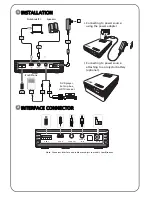
Cautions regarding viewing methods
Caution
•
If your eyes feel fatigued or uncomfortable when viewing 3D images, stop
viewing immediately. Continuing to view the 3D images could cause you to
feel unwell.
•
When viewing 3D images be sure to always wear 3D Glasses. Do not attempt
to view 3D images without 3D Glasses. Doing so could cause you to feel
unwell.
•
Do not place any breakable or fragile objects around you when using 3D
Glasses. 3D images may cause you to move your body involuntarily, resulting
in damage to nearby items or personal injury.
•
Only wear 3D Glasses when viewing 3D images. Do not move around while
wearing 3D Glasses. Your vision may appear darker than normal, causing you
to fall or injure yourself.
•
View from in front of the screen.
Viewing 3D images at an angle reduces the 3D effect and may cause you to
feel unwell due to unintended color changes.
•
If using 3D Glasses in a room with fluorescent or LED lighting, you may see
flashing or flickering throughout the room. If this should occur, reduce the
lighting until the flickering goes away or turn off the lights completely when
viewing 3D images. This flickering could trigger seizures or fainting for some
individuals. If you begin to feel uncomfortable or unwell at any time when
viewing 3D images, stop immediately.
•
Stay at least three times the height of the screen away from the screen when
viewing 3D images.
The recommended viewing distance for an 80-inch screen is at least 3 meters,
and at least 3.6 meters for a 100-inch screen. Sitting or standing any closer
than the recommended viewing distance may result in eye fatigue.
•
When viewing 3D images, we recommend using a screen size smaller than
120 inches.
If the screen size is too large, you may experience eyestrain or nausea due to
the content, viewing environment, your physical condition, and so on.
Cautions for the viewer
Caution
You should not use 3D Glasses if you are sensitive to light, have a heart
condition, or are unwell. Doing so could aggravate your pre-existing conditions.
Cautions regarding the viewing age (for children)
Caution
•
The minimum recommended age to view 3D images is six years old.
•
Children under the age of six are still developing and viewing 3D images may
cause complications. Consult your doctor if you have any concerns.
•
Children viewing 3D images through 3D Glasses should always be
accompanied by an adult.
It is often difficult to tell when a child is feeling tired or uncomfortable,
which could result in them feeling suddenly unwell. Always check that
children in your care are not experiencing any eye fatigue during viewing.
Projecting Without a Computer (PC Free)
By connecting a USB storage device such as a USB flash drive or a USB
hard disk to the projector, you can project the files stored on the device
without using a computer. This function is called PC Free.
a
•
You may not be able to use USB storage devices that incorporate
security functions.
•
You cannot correct keystone distortion while projecting in PC Free,
even if you press the [
w
] and [
v
] buttons on the control panel.
Projection Functions
57
Содержание EH-TW570
Страница 1: ...User s Guide ...
Страница 7: ...Introduction This chapter explains the projector s features and the part names ...
Страница 19: ...Remote control operating range Part Names and Functions 19 ...
Страница 20: ...Preparing the Projector This chapter explains how to install the projector and connect projection sources ...
Страница 31: ...Basic Usage This chapter explains how to project and adjust images ...
Страница 47: ...Useful Functions This chapter explains useful tips for giving presentations and the Security functions ...
Страница 81: ...Configuration Menu This chapter explains how to use the Configuration menu and its functions ...
Страница 107: ...Troubleshooting This chapter explains how to identify problems and what to do if a problem is found ...
Страница 133: ...Appendix ...
















































